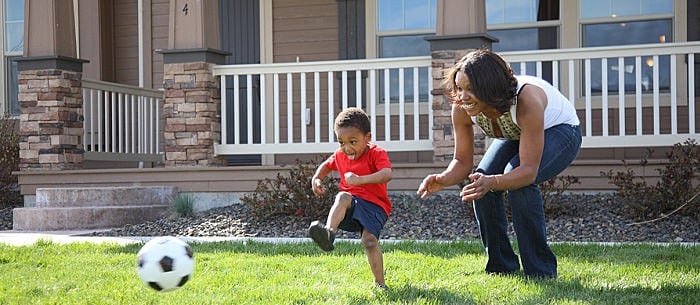Moving with children adds another very important criteria to your house selection search: It must be in a family-friendly neighborhood. It’s not enough to have a great house in a mediocre location — once kiddos are in the picture, you’re looking for the whole package. But what characteristics should you actually look for?
Here are five signs that your potentially new neighborhood will be perfect for raising your family.
1. Kid-friendly amenities
A good location will have various amenities nearby. You may hit the jackpot and be surrounded by a virtual kid haven, but more than likely you’ll have to pick and choose.
“Drive around and see if there are parks nearby. Walk through the immediate neighborhood and look for kids or signs of kids,” suggests Lori Collins Burgan, the author of “Moving with Kids” and a mom of three who has moved five times in seven years. “Sure signs of kids are play equipment (swingsets, soccer goals, trampolines) in the yards.”
2. Kids playing outside
Another indication of a kid-friendly neighborhood is, of course, kids playing outside. If possible, do some reconnaissance and drive around the neighborhood after school or on the weekends.
“It’s important to walk or drive around a neighborhood during different times of day,” says Amy Bohutinsky, chief marketing officer of Zillow. “If a neighborhood is family-friendly you will probably see school buses or kids walking to school in the morning and afternoon, and maybe kids playing outside before or after dinner.”On the flip side, a row of homes sporting “Grandpa and Grandma’s House” signs suggests an absence of full-time playmates.”A neighborhood may not be family-friendly if you see a lot of seniors,” advises Anne Violette, the founder of FunMomBlog, author of “Smooth Moving” and a mom of three who survived moving six times with young kids. Also note the age of kids in the area. If you see nothing but pre-teens hanging around, it may not be the best fit for you and your toddler
3. Friendly people
A easy way to check out the area is to take a quick walk around and chat with people. “Don’t hesitate to start conversations with people you see at the parks or playgrounds,” advises Burgan. “Ask parents what they like about living in that neighborhood and if there’s anything they don’t like.” Tell them you’re considering moving to the area. People are often quick to brag about the positives and complain about the negatives. Additionally, join BigTent parenting groups for the area — talking to other parents is an excellent way to learn about neighborhoods you’re interested in.
4. Proximity to necessities
Though the neighborhood might be great for most families, make sure it’s right for your family. If your child will be in day care, how far away is it? Is the school within walking distance or will your child need a ride? Are these locations on the way to work or 20 minutes in the wrong direction? Are you near public transportation?
And what would you give up for these necessities? 60 percent of people would be willing to live farther away from their office and have a longer commute if it meant they could live in the ideal location for their children’s school, according to a 2015 Care.com survey. ”Proximity to schools and child care is important to consider as big commutes add to family stress,” notes says Kylie Bevan, a health and relocation coach and the author of “Your Relocation Solution.” Consider what your morning commute would look like now and in the future. What will it be like with a child each in elementary, middle and high school? The last thing you want is to spend an hour or more in the car getting everyone where they need to be each morning.
5. A safe environment
Safety is very important when considering any neighborhood, but especially with little ones in tow. Is the home located near dangerous, noisy railroad tracks? Is the house near heavy traffic? Scout out businesses in the neighborhood, too — having bars within walking distance is less desirable than ice cream parlors and pizza joints when raising a family.
Are you moving to a new neighborhood far away, in another city or state? This can make researching neighborhoods more difficult. Violette suggests online resources like GreatSchools that provide ratings on schools to help inform your decision on desirable neighborhoods. She further recommends, “When you’re unable to see a neighborhood in person, use Google Earth to check out the condition of the neighborhoods. You can use the traffic tool to ‘drive around’ the streets virtually.”
With these tools and the tips above, finding a family-friendly neighborhood just got a whole lot easier.
For more ways to make your move as smooth as possible, check out these 101 Moving Tips for Families.




